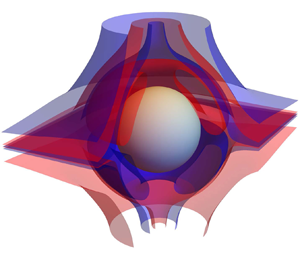Article contents
Structure of the streaming flow generated by a sphere in a fluid undergoing rectilinear oscillation
Published online by Cambridge University Press: 03 November 2023
Abstract

A solid body in a viscous fluid undergoing oscillatory motion naturally produces a steady secondary flow due to convective inertia. This phenomenon is embodied in the streaming flow generated by a sphere in an unbounded fluid executing rectilinear oscillations. We review the considerable literature on this canonical problem and summarise exact and asymptotic formulas in the small-amplitude limit. These analytical formulas are used to explore the characteristic flow structure of this problem and clarify previously unreported features. A single, toroidal-shaped vortex exists in each hemisphere regardless of the oscillation frequency, which can drive a counter-flow away from the sphere. The vortex centre moves monotonically away from the sphere with decreasing oscillation frequency, and engulfs the entire flow domain for  $\beta \equiv \omega R^2/\nu < 16.317$, where
$\beta \equiv \omega R^2/\nu < 16.317$, where  $\omega$ is the angular oscillation frequency,
$\omega$ is the angular oscillation frequency,  $R$ the sphere radius, and
$R$ the sphere radius, and  $\nu$ the fluid kinematic viscosity. This seemingly abrupt change in flow structure at the critical frequency
$\nu$ the fluid kinematic viscosity. This seemingly abrupt change in flow structure at the critical frequency  $\beta _{critical} =16.317$, and its quantification, appear to have not been reported previously. We perform a direct numerical simulation of the Navier–Stokes equations, to (1) confirm existence of this critical frequency at finite amplitude, and (2) examine its variation with amplitude. This reveals a universal relationship between the critical frequency and oscillation amplitude, clarifying previous reports on the structure of this streaming flow. The critical frequency is shown to be identical for the streaming flow and the cycle-averaged particle paths, establishing that the critical frequency is accessible directly using standard measurements.
$\beta _{critical} =16.317$, and its quantification, appear to have not been reported previously. We perform a direct numerical simulation of the Navier–Stokes equations, to (1) confirm existence of this critical frequency at finite amplitude, and (2) examine its variation with amplitude. This reveals a universal relationship between the critical frequency and oscillation amplitude, clarifying previous reports on the structure of this streaming flow. The critical frequency is shown to be identical for the streaming flow and the cycle-averaged particle paths, establishing that the critical frequency is accessible directly using standard measurements.
- Type
- JFM Papers
- Information
- Copyright
- © The Author(s), 2023. Published by Cambridge University Press
References
- 2
- Cited by



